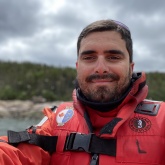Jory Cabrol

Jory Cabrol joined the Department of Fisheries and Oceans in November 2019 as a research scientist. Before to be a part of the research and conservation of marine mammals team. Dr. Cabrol was primarily interested on trophic interactions and physiological conditions of arctic and subarctic zooplankton through the use of biochemical indicators such as fatty acids, lipids and stable isotopes. Currently, Jory uses his knowledge to the preservation species at risk including the St. Lawrence beluga population, but also baleen whales in the St. Lawrence.
Current research and/or projects
Centre(s) of Expertise:
Dr. Jory Cabrol is a Research Scientist at Fisheries and Oceans Canada in Mont-Joli (Québec) with the Marin Mammal Research Division. His research focuses on characterizing beluga trophic interactions, diet and its evolution since 1930's. More specifically, his research focus on :
- Determination and quantification of diet using trophic biomarker (eg, fatty acids and stable isoptopes).
- Evolution of realized vs potential trophic niches in the actual context of climatic change and increasing human perturbation with a special focus on the last 30 years.
- How temporal changes in the feeding specialization degree may affect inter-individual and inter-specific competition for share ressources in the St. Lawrence
- The application, validation and development of trophic ecology theories and their application to marine mammal species.
Education and awards
Degrees:
- PhD. in Oceanography (2018) University of Québec at Rimouski, Quebec
- MSc. in Oceanography (2013) University of Québec at Rimouski, Quebec
- Licence in Marine and Environnemental Science (2010), University of Aix-Marseille II, France (French equivalent of BSc)
- D.U.T (two-year university degree in technology) in Biological Engineering (2008), I.U.T Paul Sabatier in Toulouse, France
Awards:
2022 : Postdoctoral research scholarship (FQRNT)
2019 : Named to the Dean’s honor list for outstanding academic record (Ph.D)
2018 : Merit scholarship University of Québec at Rimouski
2015 : Merit scholarship for foreign student - doctoral research scholarship (FQRNT)
Additional links
Research gate : https://www.researchgate.net/profile/Jory_Cabrol
Key publications
- Simond, A.É., Ross, P.S., Cabrol, J., Lesage, V., Lair, S., Woudneh, M.B., Yang, D., Peng, H., Colbourne, K. and Brown, T.M., 2023. Declining concentrations of chlorinated paraffins in endangered St. Lawrence Estuary belugas (Delphinapterus leucas): Response to regulations or a change in diet? Sci. Tot. Env., p.161488.
- Cabrol, J., Lesage, V., Leclerc, A., Giard, J., Iverson, S., Bérubé, M., Michaud, R. and Nozais, C. (2021). Individual and population dietary specialization decline in fin whales during a period of ecosystem shift. Sci. Rep., 11(1):17181.
- Bernier-Graveline, A., Lesage, V., Cabrol, J., Lair, S., Michaud, R., Rosabal, M., & Verreault, J. (2021). Lipid metabolites as indicators of body condition in highly contaminant-exposed belugas from the endangered St. Lawrence Estuary population (Canada). Env. Res., 192:110272.
- Cabrol J., Tremblay R., Winkler G. (2020). Differential eco-physiological performances of two pseudocryptic species of the Eurytemora affinis complex in the St. Lawrence estuarine transition zone: a reciprocal transplant experiment. Crustaceana. 93.3-5: 379-404.
- Cabrol J., Starr M., Tremblay R., Nozais C., Plourde S., Fabre A., Winkler G. (2020). Functional feeding response of Meganyctyphanes norvegica and Thysanoessa raschii: The importance of phytoplankton and zooplankton. J. Plankton Res., 179:102203.
- Cabrol J., Nadalini J.B., Tremblay R., Nozais C., Starr M., Plourde S., Winkler G. (2019b). Seasonal and large scale spatial variability of the energy reserves and the feeding selectivity of M. norvegica and T. inermis in a subarctic environment. Prog. Oceanography. 178: 102203.
- Cabrol J., Trombetta T., Amaudrut S., Aulanier F., Sage R., Tremblay R., Nozais C., Starr M., Plourde S., Winkler G. (2019a). Trophic niche partitioning of dominant North Atlantic krill species, Meganyctiphanes norvegica, Thysanoessa inermis, and T. raschii. Limnol. Oceanogr., 64:165-181.
- Benkort D., Plourde S., Winkler G., Cabrol J., Ollier A., Cope L.E., Maps F. (2018). Individual-based modelling explains the contrasted seasonality of size, growth and reproduction of the sympatric Arctic (Thysanoessa raschii) and Nordic krill (Meganyctiphanes norvegica) in the St. Lawrence Estuary, eastern Canada. Limnol. Oceanogr., 63:217-237.
- Winkler G., Cabrol J., Favier J.B. (2016). La diversité, la répartition et l’écologie du complexe d’espèces cryptiques Euytemora affinis dans la zone d’alevinage de l’estuaire moyen du Saint-Laurent. Nat. Can., 140:7-18.
- Cabrol J., Winkler G., Tremblay, R. (2015). Physiological condition and differential feeding behaviour in the cryptic species complex Eurytemora affinis in the St Lawrence estuary. J. Plankton Res., 37:372-387.
- Gazave E., Lavrov D.V., Cabrol J., Renard E., Rocher C., Vacelet J., Adamska M., Borchiellini C., Ereskovsky A.V. (2013). Systematics and molecular phylogeny of the family Oscarellidae (Homoscleromorpha) with description of two new Oscarella species. PLoS ONE, 8(5),e63976.
 ORCID
ORCID